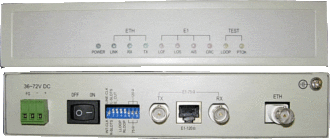- In accordance with the provisions of IEEE 802.3、802.3u Ethernet, ITU-T G.703, G.704 and G.823 protocols.
- E1 interface framing/un-framing optional; balanced 120ohm unbalanced 75ohm optional.
- The E1 interface uses PCM31 mode, supporting CRC check.
- E1 interface main/ slave clock optional in the framing mode.
- In the E1 framing mode, the number of time slots is optional from 1 to 31.
- Supporting 2.048Mbps transparent transmission in the E1 un-framing mode.
- The 10BASE-2 Ethernet interface supports 10M half/ full duplex modes.
- MAC addresses self-learning and addresses filtering functions, reducing the transmission load of the E1 circuit.
- Built-in 64Mbits SDRAM Ethernet data buffer memory, improving the capability of Ethernet side anti-outburst, assuring high throughput of data transmission.
- E1 circuit remote loop and local loop tests.
- Pseudo random sequence test, facilitating the test of E1 circuit.
- Perfect circuit test and alarm indication.
- Two architectures: stand alone and 19in rack mount architecture (15 interface converter modular and one NMS modules or 16 interface converter modules can be inserted in the rack mount architecture) ;
- Optional AC 220V or DC –48V input for bridge of both architectures
- Hot rear up of double power supplies is provided for the Bridge of rack mount architecture, assuring high reliability.
- Supports local Hyper Terminal management via RS232 serial port and remoter management by Telnet、Web、SNMP and CGI management software.
Protocol: G.703, G.704, G.736, G.823, I.431
IEEE802.3 10BASE-2
Circuit interface (E1):
Impedance: 75ohm, physical interface: BNC
Impedance: 120ohm, physical interface: RJ45
Interface rate: framing: N*64Kbps,N=0~31;
Un-framing: 2.048Mbps
Coding: HDB3, Jitter tolerance in accordance with G.823 Output jitter<0.05UI
Data interface (10BASE-2):
Impedance: 75ohm, physical interface: BNC
Interface rate: 10Mbps
Coding: Manchester
Cable: 75ohm coaxial-cable, UTP5 twisted pair。
Transmission range:
circuit interface: BNC: 600m; RJ45: 300m; Data interface: 300m
Indicators: indicating power, connection states of data and circuit interfaces, operation state, test state and trouble alarm.
Dimensions:
stand alone: 140mm (dep) x 210mm (wid) x 40mm (hei)
Rack mount: 19in standard 4.5U cabinet
Power supply:
stand alone: 85V~264V AC input, 5V/1A output
-36V~-72V DC input,5V/1A output
rack mount:150V~260V AC input,5V/16A、12V/1A output
-38V~-58V DC input,5V/16A、12V/1A output
Power dissipation: 3W
Operational temperature: 0℃~50℃
Storage temperature: -20℃~80℃
Humidity: 5%~90% (no condensation)
Application example:
| AN-FE1-ETH2 | E1 framed G.703/G.704 to 10Base2 coax BNC type Ethernet converter, AC or DC power |
Description
AN-FE1-ETH2 Framed E1 G.703/G704 to 10BASE-2 Interface Converter (E1 – Ethernet Bridge) is an interface converter of high performance, which accomplishes the converting between the 10MBit/s Ethernet port and the E1 port.
As an extended device of the Ethernet, the FE1/10BASE-2 bridge realizes interconnection of two Ethernet by using the E1 channel provided by existing networks with low cost.
10BASE-2(BNC) interfaces are provided at the end of Ethernet LAN to accomplish various functions including MAC address self-learning, address filtering, address table maintenance and flow control.
E1 interfaces conforming to ITU-T G.703 and G.704 proposals are provided at the end of WAN, supporting RJ45 and BNC connection modes. The E1 ports support both framing and un-framing architecture. The user can select an operating mode for the E1 interface according to the connected E1 environment. This provides flexibility of network application. In the framing mode, the E1 interface provides a rate of N*64Kbps(N=1~31). In the un-framing mode, the E1 channel provides a rate of 2.048Mbps and accomplishes transparent transmission.
If the FE1/10BASE-2 bridge is used in the framing mode, the transmission clock can be either provided internally, i.e. using the main clocking timing mode (INT), or extracted from the E1 channel, i.e. using slave clock timing mode.
The FE1/10BASE-2 bridge provides plenty of self-test functions, supporting local loop and remote loop. It also provides pseudo random code test function to test error codes in the circuit.
It is proposed but mandatory to use the products of this series in pairs.
Additional information
| 10Base-2 ports (Coax) | 1 |
|---|

